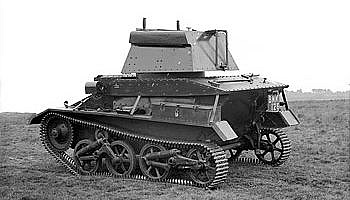Britain’s Mark IV light tank, which was developed by Vickers in the 1930s, was the first light tank in which the armored hull formed the chassis. Automotive parts were bolted onto the hull.
Its design was based on that of experimental “Indian Pattern” armored vehicles by Vickers.
The Mark IV had a longer hull than the Mark III. It had thicker armor and a higher superstructure than the Mark III.
The turret of the Mark IV was similar to that of the Mark III. The Mark IV’s turret was set closer to the back of the tank than in previous versions of light tanks. Some versions of the Mark IV, which were sent to India, had a cupola.

Like its predecessors, the Mark IV had a Horstmann suspension. The idler wheel – the guide wheel that supports the tank track – was eliminated from the Mark IV.
Mark IV Light Tank |
|
|---|---|
| Active: | 1934 |
| Crew: | 2 |
| Weight: | 4.6 tons (4,674kg) |
| Length: | 11ft 2in (3.40m) |
| Height: | 7ft (2.13m) |
| Width: | 6ft 9in (2.06m) |
| Weapons: | 1 x 0.303in (7.7mm) and 1 x 0.5in (12.7mm) machineguns |
| Armor | Maximum – 0.47in (12mm) |
| Engine: | Meadows 6-cylinder gasoline, 88hp |
| Speed: | 35 mph (56 kph) |
| Range: | 125 miles (201 km) |